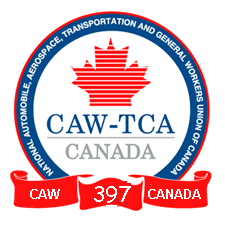|

OUR HISTORY
(1937 TO 2001)
THE
FORMATION OF THE CAW (UAW) IN BRANTFORD
In 1936, the
Congress of Industrial Organizations was born in the United
States, a by-product of the internal wrestling with in the
American Federation of Labour regarding the proposal to organize
mass production industry on an industrial basis. John L. Lewis, of
the United Mine Workers, rejected the exclusivity of the
anachronistic craft union and withdrew from the ALF to form the
CIO.
With in a year, the CIO had crept into Canada in an attempt to
organize autoworkers at the General Motors Plant in Oshawa. The
premier of Ontario, Mitch Hepburn, declared war on the CIO, using
every available tool to squelch the resulting strike at the Oshawa
plant - a strike that was to have tremendous ramifications for the
country as a whole.
Local labour organizers viewed the events in Oshawa with keen
interest and intent. Specifically, a group of employees from the
Brantford Carriage Works convened a meeting with UAW
representatives at the Trades and Labour Hall. At the end of the
meeting, fifty-three workers made the decision to sigh up and on
May 4, 1937, Charles Millard, head of the Canadian Region of the
UAW, presented Local 397 with a charter. Four days later, a
contingent of employees from the Adams Wagon Works indicated their
willingness to join the newly-formed union and the seed that would
eventually germinate into one of the most powerful forces in the
city was planted.
One of the original members of the union, Reg Cooper, later Mayor
and city clerk of the municipality, recalled in an interview with
the Expositor that local workers were very much influenced the
success of the GM strike, particularly in combination with local
grievances.
He described the fragility of an almost nonexistent job security
in which men with as much as fifty years tenure could be laid off
without warning or preparation. In the mid-thirties, wages were
cut at the Carriage Works by forty cents an hour. There was no pay
for overtime.
The founding nucleus of Local 397, struggled to overcome minority
status within their places of employment, meagre funds, token
recognition from management and a resulting and predictable
diminished interest amongst waning members. In November 1938,
President Cameron Jacques, reluctantly surrendered the charter to
the UAW regional director, George Burt, Millards successor, who,
in a rare show of good faith, kept the charter in his desk, rather
than return it to Detroit as he had been instructed. Four years
later, the charter was returned to the Local, whose centre of
organization was still the Brantford Carriage Works newly named,
The Brantford Coach and Body.
The UAW sent a representative, Robert Stacey, who began to
organize other local plants in earnest of a successful membership
drive, He eventually signed up members of Canada Car and foundry,
Robbins and Myers and as many as twenty-five others.
The second UAW local in Brantford, 458, developed from the Markets
St. plant of Massey-Harris Co. and the Mohawk St. plant of
Cockshutt Farm Equipment. The UAW represented a dynamic departure
in labour tradition for the two plants whose "union"
were financed by the company and whose functions were primarily as
listening posts and petty complaint boxes. Local 458 launched a
major membership drive within the two plants on the heels of the
expulsion of the "company union" in 1943. Massey-Harris
was the first of the two plants to sign up. In fact, Cockshutt
workers voted to reject the UAW in a meeting held on May 20, 1943,
preferring to adhere to the company union until it was banned
later on in the year through provincial legislation.
On August 10, Local 458 was officially chartered by the uaw. The
Coach and Body was among the first plants to implement the
recommendations of the Rand report which provided that all members
of the bargaining unit, union and non-union must have dues
deducted from their pay cheques, and the amount turned over to the
union. Within ten years, both locals had achieved prominent status
within the community, despite the negative catcalls of the press
and the reluctance of the local industrial establishment to
welcome them with open arms. The UAW was able to make significant
gains and won contract benefits that made their plants the envy of
the other Brantford factories.
Trailmobile, a member of 397, had a cost of living clause
introduced into their contract in the 1950's. Members of Local 458
at Massey and Cockshutt's had a company guarantee to pay
supplemental unemployment benefits to laid off workers. The unions
also introduced health benefits and insurance policies into their
negotiations during the fifties. In the sixties the emphasis was
on the inclusion of drug plans and seniority clauses.
The significance of the solidification of the modern industrial
trade union in Brantford, as in all of North America, lies in its
measurable alteration on the status of the union as equal to the
giant corporation. The working man and woman found their most
powerful ally in the development of industrial unionism.
The
above excerpt was taken from a book written by Elizabeth Kelly,
for Local 397, called "OUR EXPECTATIONS, A HISTORY OF
BRANTFORD'S LABOUR MOVEMENT."
Back
to the top
|